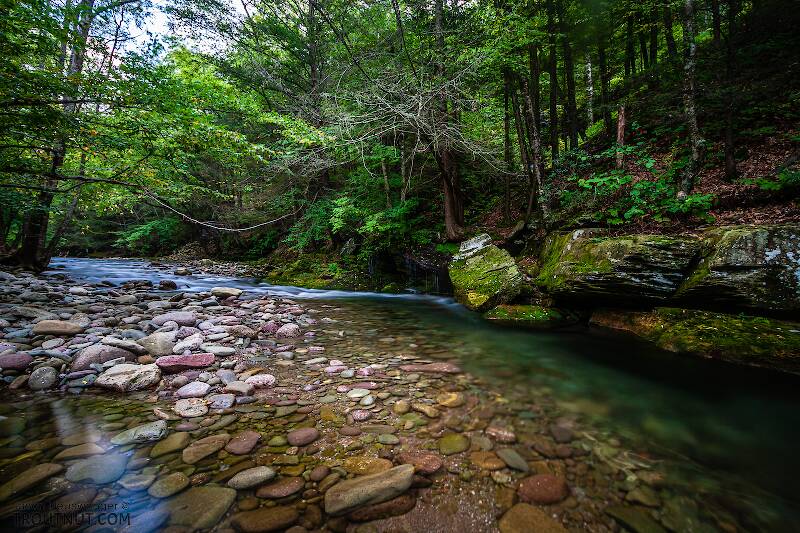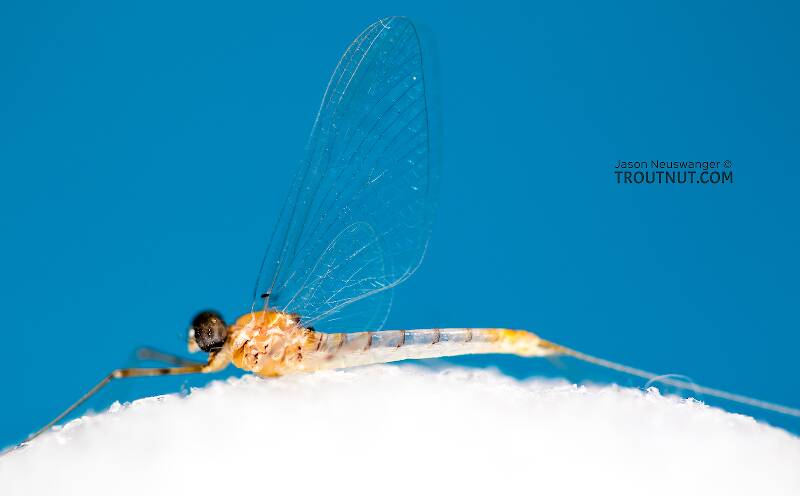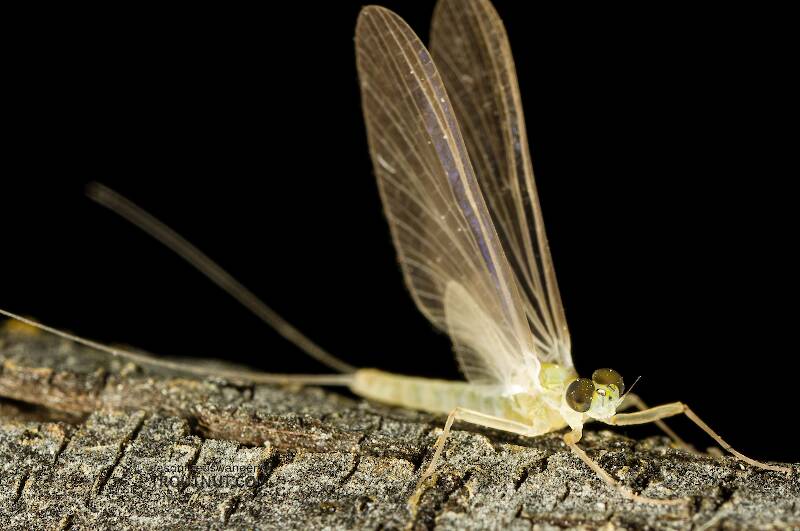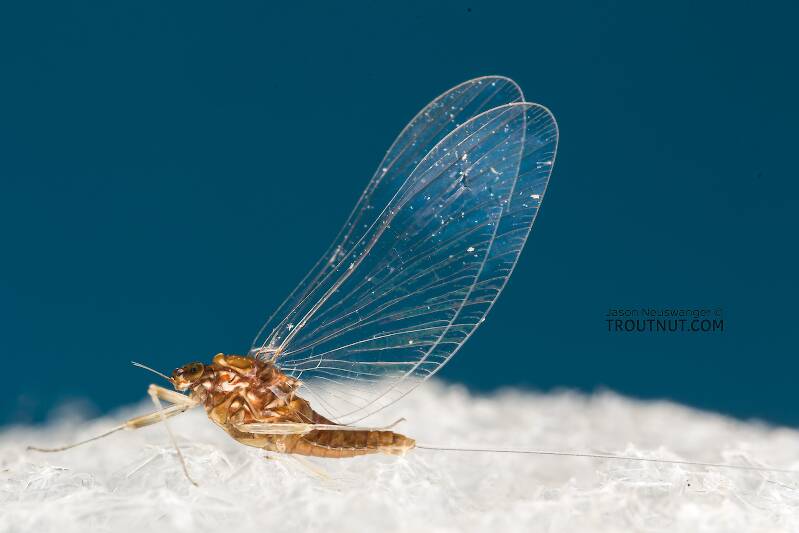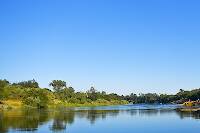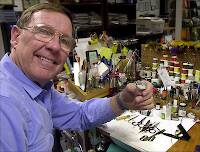
Hex Mayflies
Hexagenia limbata
The famous nocturnal Hex hatch of the Midwest (and a few other lucky locations) stirs to the surface mythically large brown trout that only touch streamers for the rest of the year.
Featured on the forum

This specimen appears to be of the same species as this one collected in the same spot two months earlier. The identification of both is tentative. This one suffered some physical damage before being photographed, too, so the colors aren't totally natural. I was mostly photographing it to test out some new camera setting idea, which worked really well for a couple of closeups.

Troutnut is a project started in 2003 by salmonid ecologist Jason "Troutnut" Neuswanger to help anglers and
fly tyers unabashedly embrace the entomological side of the sport. Learn more about Troutnut or
support the project for an enhanced experience here.
This topic is about the Insect Order Ephemeroptera
Mayflies may be the most important insects for trout anglers to understand. They are an ancient order of insects, famous outside the fly-fishing world for their fragile beauty and short adult lifespan, often a single day to mate and die. The mayfly's poignant drama attracts poets and anglers alike, but anglers make the most of it.Mayflies live more than 99% of their lives as nymphs on the river or lake bottom, filling many crucial roles in freshwater ecosystems as they feed and grow. They eventually emerge from the water as winged sub-adults called "subimagos" by scientists and "duns" by anglers. Duns evolved to be good at escaping the water, with a hydrophobic surface and hardy build, but they are clumsy fliers. Within a day or two they molt one last time into "imagos" or "spinners," the mature adults, a transformation captured in this photo series of a dun molting into a spinner. They have longer legs and tails, and sleeker, more lightweight bodies, giving them the airborne speed, agility, and long grasp they need for their midair mating rituals. They are usually darker than the duns and have shinier, more transparent wings. They die within minutes or hours after mating.
Example specimens
Cgrier
Posts: 1
Posts: 1
Cgrier on Jun 24, 2007June 24th, 2007, 1:32 pm EDT
I witnessed what I think was a mayfly swarm along Ohio River Blvd in Pittsburgh on Thursday, June 21st at dusk. The insects created spinning columns that were about 30-80 feet high. There were about 150-200 of these columns for about 1/2 mile along the hillside just above the sewage treatment plant, and also above a stream that feeds into the Ohio. I have been searching but can't find any documentation that the swarming behavior occurs in this column pattern. Is anyone familiar with this?
Martinlf on Jun 25, 2007June 25th, 2007, 4:50 am EDT
It sounds like mating spinners to me.
"He spread them a yard and a half. 'And every one that got away is this big.'"
--Fred Chappell
--Fred Chappell
JOHNW on Jun 26, 2007June 26th, 2007, 10:34 am EDT
I'll second Louis on the mating swarms.
We get very similar occurances on the Susquehanna.
Out of curiosity how big were these bugs? Are we talking Hummingbird or smaller?
I know the Pittsburgh area sees some pretty dramatic Hexegenia hatches. They sort of bring Alfred Hitchcok's BIRDS to mind and I'm sure to head the other way.
JW
We get very similar occurances on the Susquehanna.
Out of curiosity how big were these bugs? Are we talking Hummingbird or smaller?
I know the Pittsburgh area sees some pretty dramatic Hexegenia hatches. They sort of bring Alfred Hitchcok's BIRDS to mind and I'm sure to head the other way.
JW
"old habits are hard to kill once you have gray in your beard" -Old Red Barn
Konchu on Jul 1, 2007July 1st, 2007, 7:19 am EDT
This thread reminded me of an old report of a mayfly swarm that I thought some might enjoy.
"...a great swarm of ephemerids...passed through the town of Lewisburg, on the Susquehanna River, on the afternoon of the 22nd of August. The swarm was estimated to be about a mile in length by nearly a half mile in width, and was so dense as even to obscure passers by on the opposite side of the street."
Gentry, TG. 1873. Proceedings of the Academy of Natural Sciences of Philadelphia, volume 25, 3rd series, page 350.
"...a great swarm of ephemerids...passed through the town of Lewisburg, on the Susquehanna River, on the afternoon of the 22nd of August. The swarm was estimated to be about a mile in length by nearly a half mile in width, and was so dense as even to obscure passers by on the opposite side of the street."
Gentry, TG. 1873. Proceedings of the Academy of Natural Sciences of Philadelphia, volume 25, 3rd series, page 350.
Aaaa
Posts: 1
Posts: 1
Aaaa on Sep 26, 2007September 26th, 2007, 4:33 am EDT
Just wanted to add that I saw a series of insect swarms a couple of days ago (late Sept). These were also tall spinning columns, near water in a line above a row of trees paralleling a highway. Also at dusk, temp about 80, and also just across the highway from a sewage treatment plant. I'd have guessed about 30 columns in view, each around 40 feet high. I didn't get close enough to tell what the insect might be, but bigger than a housefly. This is in Washington DC.
Wbranch on Mar 14, 2008March 14th, 2008, 3:40 pm EDT
Catskill fly fisher for fifty-five years.
Creno on Mar 15, 2008March 15th, 2008, 3:56 am EDT
Folks from the east may already know of this but here is a link to an article about a big swarm.
http://seagrant.psu.edu/publications/fs/Mayfly_12-2003.pdf
http://seagrant.psu.edu/publications/fs/Mayfly_12-2003.pdf
Quick Reply
Related Discussions
Topic
Replies
Last Reply
1
Jun 10, 2010
by Dryfly
by Dryfly
16
Sep 22, 2011
by Oldredbarn
by Oldredbarn

